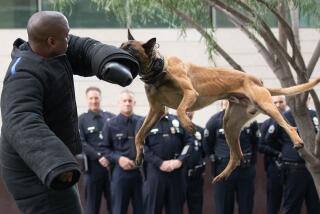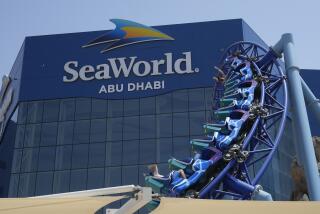Killer whales endanger park staff, state says
SAN DIEGO — SeaWorld officials Thursday hotly disputed a finding by state investigators that it is “only a matter of time” before a trainer is killed by one of the park’s killer whales.
“The trainers recognize this risk and train not for ‘if’ an attack will happen but ‘when,’ ” said a report by the state Division of Occupational Safety and Health.
The report, released Tuesday, follows an investigation into a Nov. 29 incident in which Kasatka, a 7,000-pound, 17-foot-long female, dragged her trainer underwater in front of hundreds of horrified spectators at Shamu Stadium.
SeaWorld officials branded the report’s findings “highly speculative and not supported by scientific fact” and met Thursday with the Cal/OSHA district manager to ask him to withdraw or modify the report.
“We have proven over 40 years that we are very safe,” said Mike Scarpuzzi, vice president of zoological operations at SeaWorld San Diego and a former whale trainer. He noted that the park has never had a fatality despite “millions” of interactions between whales and trainers.
The report asserts that although SeaWorld employees immediately used a variety of rescue procedures when the trainer was dragged under, all the procedures failed. The whale refused to comply with commands from other trainers to turn Kenneth Peters loose.
Peters, 39, the park’s most experienced whale trainer, escaped only through his own quick thinking and endurance, suffering puncture wounds and a broken foot, the report concluded.
Scarpuzzi said the finding that safety procedures failed is incorrect and that one reason the whale surfaced was that a net was dropped into the water.
“The emergency procedures worked,” he said. “We have a whale and a trainer, and both are alive. That’s a successful end.”
No decision was announced after Thursday’s meeting, which Scarpuzzi said involved “a healthy amount of assertiveness.”
State investigators said in the report that SeaWorld has done a good job preparing its trainers to work with killer whales and that there are no grounds for citing the park for any safety violations.
But the report also warned that SeaWorld should be ready to use lethal force against a killer whale if the animal endangers a trainer by going “out of control and not responding to other available control measures.”
Although the SeaWorld trainers are experienced and well schooled in animal behavior, the risk of swimming with the behemoth mammals cannot be eliminated, the report said.
The shows in which the whales perform at Shamu Stadium are the centerpiece of the SeaWorld experience for most tourists.
At the command of trainers, the animals perform a series of spectacular tricks. The showstopper is when a whale rockets to the surface with a trainer riding on its nose.
The whales “are a danger to humans by virtue of their size alone,” the report said. “Second, they are a carnivore. They are armed with an impressive arsenal of teeth, capable of tearing bone and flesh.”
The whales are also smart and capable of “cunning and forethought,” the report states.
Peters told investigators that he had no warning that Kasatka was going to drag him to the bottom of the 36-foot-deep pool. “She didn’t show me any precursors. She didn’t tell me; she didn’t show me,” the report quoted him as saying.
Animal rights groups have long criticized SeaWorld for keeping killer whales in captivity. The park has seven killer whales; during the height of the summer tourist season, there are often six to seven shows a day at Shamu Stadium.
Dean Fryer, a Cal/OSHA spokesman, said SeaWorld’s concerns would be reviewed.
“We will take their views into consideration,” he said. “We may or may not make changes.”
*
More to Read
Sign up for Essential California
The most important California stories and recommendations in your inbox every morning.
You may occasionally receive promotional content from the Los Angeles Times.










